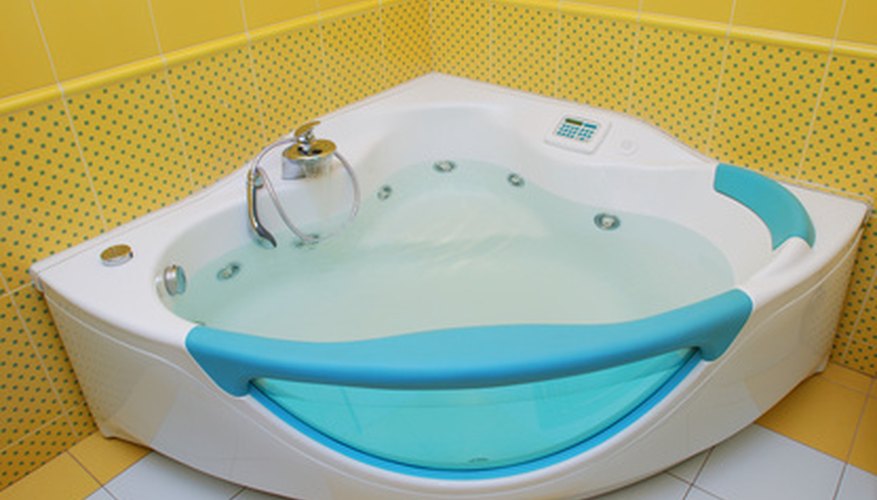It is not common practice to insulate bathtubs. However, due to an increase in energy-conservation awareness over the past decades, more people are remodelling their bathrooms, using energy-efficient materials and fixtures. One of the steps you can take toward reducing energy waste in your home is installing insulation under the bathtub and in the cavities surrounding it. Materials designed to preserve thermal energy have the ability to keep the water in the tub warm for longer, promoting energy savings.
Insulating New Bathtubs
When installing a new bathtub, it's a good idea to have a professional installer spray foam the underside of the bathtub or install polyiso (polyisocyanurate) sheathing boards between the joints. Whether the bathtub is installed on structural floors, directly on concrete or on a tiled deck, the polyiso insulation will slow down the transfer of thermal energy during the winter months. Polyiso has an R-7 thermal resistance value, which is recommended for insulating bathtubs. The expanded foam insulation also will prevent condensation resulting from the difference between water temperature and the exterior temperature. Condensation often can lead to mould formation or wood rot, which can cause structural damages to your home. You can avoid these problems by applying foam spray insulation in the hollow spaces around and under the tub.
- When installing a new bathtub, it's a good idea to have a professional installer spray foam the underside of the bathtub or install polyiso (polyisocyanurate) sheathing boards between the joints.
- You can avoid these problems by applying foam spray insulation in the hollow spaces around and under the tub.
Insulating a Bathtub during a Remodeling Project
A bathroom remodelling project gives you the perfect opportunity to replace the bathtub with a better insulated one. If replacing the bathtub is too costly or inconvenient, you can remove the panelling around the old bathtub and apply foam insulation around the three edges that rest against walls. If you complete the project yourself, check the plumbing to make sure there are no leaks between the walls and the edges of the tub. Moisture infiltration often leads to poor insulation and mould. When insulating a whirlpool bath, avoid spraying foam around electrical components or jets. The expanding foam insulation may clog the plumbing or the system that operates the jets.
- A bathroom remodelling project gives you the perfect opportunity to replace the bathtub with a better insulated one.
- If replacing the bathtub is too costly or inconvenient, you can remove the panelling around the old bathtub and apply foam insulation around the three edges that rest against walls.
Insulating Outdoor Bathtubs
For those who enjoy an outdoor bathtub, there are insulating materials designed especially for outdoor use. In addition to thermal insulation properties, this type of insulating material also has anti-reflective characteristics that prevent energy waste, while prolonging the life of the tub.
Insulation Materials You Need
Polyiso foam (spray-on foam) is dense enough to provide thermal insulation and to prevent the tub walls from generating a hollow sound. Once installed, the material forms a bond to the tub walls, preventing air movement within. Spray-on foam also can be combined with rigid foam (like the regular styrofoam used for packing and shipping) for even better insulation. You can find various brands of spray-on foam at home-improvement stores at a relatively low cost. Foil-faced polyiso sheets can be purchased at home-improvement centres as well. If you install insulating sheets, you will need lightweight framing under the deck to hold the sheets in place. When installing a new bathtub, you can also use Fiberglas to fill the space underneath the tub.
- Polyiso foam (spray-on foam) is dense enough to provide thermal insulation and to prevent the tub walls from generating a hollow sound.
- Spray-on foam also can be combined with rigid foam (like the regular styrofoam used for packing and shipping) for even better insulation.
What You Should Avoid
If your bathtub is set against outside walls or on a concrete floor with little or no thermal insulation, avoid using Fiberglas as an insulating material. The moisture resulting from condensation could infiltrate the Fiberglas, which takes a long time to dry.
